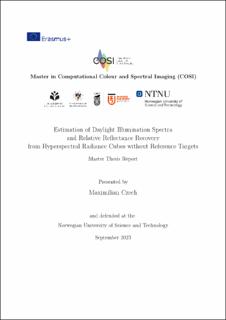| dc.description.abstract | When working with hyperspectral images, a crucial step is to correctly identify the illumination conditions and remove their influence from the recorded scenes.
While the most common approach is to capture a reference target of known reflectance as a ground truth measurement, this might not be sufficient for specific applications under certain conditions, such as unmanned aerial vehicles (UAV) based captures of forests and agricultural areas.
Here, the proper placement of reference targets within the scene can be complicated or impossible, and time-separated captures for scene and calibration can be insufficient due to changes in cloud coverage or similar effects.
A possible solution to this problem is the estimation of the illuminant from the scene capture directly without the use of a calibration target.
Different approaches exist to tackle this underconstrained problem, mainly based on image statistics or by making use of the physical properties of the recorded objects.
Nevertheless, each of those algorithms has its flaws, such as the dependency on objects with specific properties, for example convex surfaces or a large variety of different reflectance properties, while other approaches rely on the identification of specular highlights.
These constraints might not be sufficient for applications involving vegetation such as agriculture or environmental monitoring, and therefore a need exists for the development of precise illumination estimation algorithms.
In this work, a novel image statistics-based approach is proposed to estimate the relative spectral power distribution (SPD) of daylight illuminants from a given hyperspectral radiance cube.
The created method restricts the possible results in the spectral domain by applying an effective constraint to limit the search area by utilizing the information inherited in the image cube.
Within the resulting search area, a set of random spectra are generated which represent the image-dependent plausible illuminants.
These spectra are then transferred into a pre-trained, image-independent principal component space, where an intersection between these image-dependent plausible illuminants and a set of measured physically possible illuminants is calculated.
The scene illuminant is then derived by transforming this intersection point back to the spectral domain, where the estimated illuminant can be used to recover the relative scene reflectance values.
The framework created in this work is tested on a set of 150 hyperspectral radiance cubes simulated by using 25 spectral reflectance cubes and six representative daylight SPDs.
The daylight illuminants are chosen based on their inverse correlated color temperature and cover a broad range from vertical daylight, and overcast sky to clear blue sky conditions.
The estimated (SPD) and the recovered reflectance spectra are evaluated using several well-adopted full reference metrics for spectral comparison.
In addition, the performance of the proposed model is compared to several other image statistics-based illuminant estimation methods and it is demonstrated that the new model outperforms the competitors significantly.
The results clearly show the ability of the proposed model to accurately estimate the SPD of a representative variety of common daylight illuminants in the VIS and NIR range. | |
